Java Web——过滤器 & 监听器
目录
2.2.1.1. ServletContextListener监听器
2.2.1.2. ServletContextAttributeListener监听器
2.2.2.2. HttpSessionListener 监听器
2.2.2.3. HttpSessionAttributeListener 监听器
2.2.2.5. ServletRequestListener 监听器
2.2.2.6. ServletRequestAttributeListener 监听器
2.2.3.1. HttpSessionBindingListener 监听器
2.2.3.2. HttpSessionActivationListener 监听器
1. Filter & 过滤器
1.1. 过滤器概述
Filter是Java Web开发中的一种技术,它可以对目标资源的请求进行过滤。简单来说,Filter就像是一个前置处理器或者拦截器,它会在目标资源被请求之前执行,对请求进行一定的处理或者拦截。
- Filter接口是Filter的开发规范,所有开发的Filter都需要实现这个接口。当一个请求到达Filter时,容器会先创建一个HttpServletRequest和HttpServletResponse对象,然后调用Filter的doFilter方法。
- doFilter方法决定了一个请求是否可以继续执行。如果doFilter方法允许请求继续,那么请求将会被转发到目标资源。如果doFilter方法拒绝了请求,那么请求就会在这个Filter中停止,由Filter自己对请求做出响应。
- 除了对请求进行过滤,Filter也可以在目标资源响应之前对响应进行再次处理。因此,Filter不仅可以用于对请求的过滤,也可以用于对响应的处理。
- Filter是GOF(设计模式)中责任链模式的典型案例。责任链模式是指多个对象形成一个处理请求的链条,每个对象都有机会处理请求,直到有一个对象处理了请求为止。
- Filter的常用应用非常广泛,包括但不限于登录权限检查、解决网站乱码、过滤敏感字符、日志记录、性能分析等。这些应用都是通过Filter技术实现的。
举个例子:
生活举例中,公司前台、停车场安保和地铁验票闸机都是Filter的典型应用。它们都可以对进入的人员或者车辆进行审核和过滤。如果符合条件,就放行;如果不符合条件,就拒绝进入。同时,它们也可以在人员或者车辆离开时进行再次审核和收费。
Filter工作原理图解:
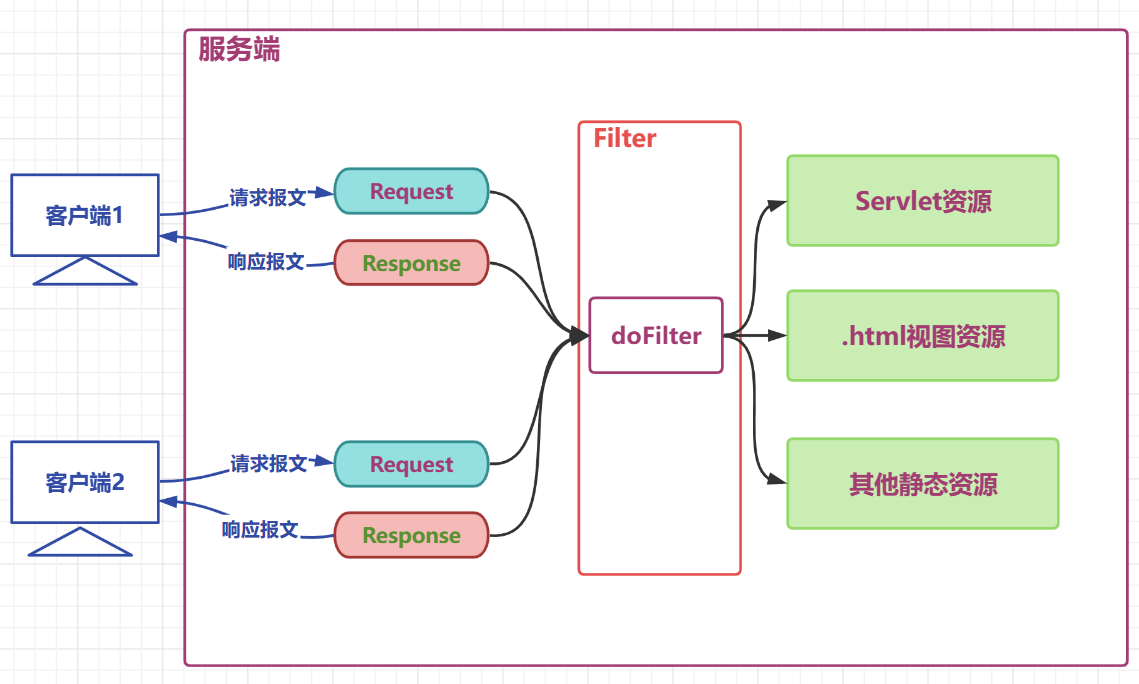
Filter接口API:
从IDEA上面的Filter.java上扒下来的源码,也就三个抽象方法:
- init(FilterConfig filterConfig):这是过滤器初始化时调用的方法。在这个方法中,可以设置过滤器的一些配置信息,如参数等。默认的实现是不执行任何操作。
- doFilter(ServletRequest request, ServletResponse response, FilterChain chain):这是过滤器的主要工作方法。每次客户端请求资源时,都会调用此方法。在这个方法中,可以根据需要修改请求和响应对象,并决定是否将请求传递给下一个过滤器或目标资源。这通常涉及检查请求,可能修改请求或响应,然后调用chain.doFilter()来继续过滤器链,最后可能直接在响应上设置头信息。
- destroy():这是过滤器被移除服务时调用的方法。在这个方法中,可以进行一些清理工作,例如释放资源,确保所有持久状态与内存中的当前状态同步。默认的实现同样不执行任何操作。
1.2. 过滤器的使用
目标:开发一个日志记录过滤器
- 用户请求到达目标资源之前,记录用户的请求资源路径
- 响应之前记录本次请求目标资源运算的耗时
- 可以选择将日志记录进入文件,为了方便测试,这里将日志直接在控制台打印
LoggingFilter.java 过滤器
package filter;
import javax.servlet.*;
import javax.servlet.http.HttpServletRequest;
import javax.servlet.http.HttpServletResponse;
import java.io.IOException;
import java.text.SimpleDateFormat;
import java.util.Date;
public class LoggingFilter implements Filter { //实现Filter接口
public void init(FilterConfig config) throws ServletException {
System.out.println("以启用登录过滤器~");
}
private final SimpleDateFormat dateFormat =new SimpleDateFormat("yyyy-MM-dd HH:mm:ss");
@Override
public void doFilter(ServletRequest servletRequest, ServletResponse servletResponse, FilterChain filterChain) throws IOException, ServletException {
// 参数父转子
HttpServletRequest request =(HttpServletRequest) servletRequest;
HttpServletResponse response =(HttpServletResponse) servletResponse;
// 拼接日志文本
String requestURI = request.getRequestURI();
String time = dateFormat.format(new Date());
String beforeLogging =requestURI+"在"+time+"被请求了";
// 打印日志
System.out.println(beforeLogging);
// 获取系统时间
long t1 = System.currentTimeMillis();
// 放行请求
filterChain.doFilter(request,response);
// 获取系统时间
long t2 = System.currentTimeMillis();
// 拼接日志文本
String afterLogging =requestURI+"在"+time+"的请求耗时:"+(t2-t1)+"毫秒";
// 打印日志
System.out.println(afterLogging);
}
@Override
public void destroy() {
System.out.println("以销毁登录过滤器~");
}
}
配置web.xml
不配置web.xml就是普通的java类,无法实现filter过滤器的功能
<?xml version="1.0" encoding="UTF-8"?>
<web-app xmlns="http://xmlns.jcp.org/xml/ns/javaee"
xmlns:xsi="http://www.w3.org/2001/XMLSchema-instance"
xsi:schemaLocation="http://xmlns.jcp.org/xml/ns/javaee http://xmlns.jcp.org/xml/ns/javaee/web-app_4_0.xsd"
version="4.0">
<!--配置过滤器-->
<filter>
<filter-name>loggingFilter</filter-name> <!--过滤器名称-->
<filter-class>filter.LoggingFilter</filter-class> <!--过滤器类名-->
</filter>
<filter-mapping>
<filter-name>loggingFilter</filter-name> <!--过滤器名称-->
<url-pattern>/*</url-pattern> <!--过滤器拦截的url,/* 表示对所有资源进行过滤-->
</filter-mapping>
</web-app>说明:
ServletA.java
package servlet;
import javax.servlet.annotation.WebServlet;
import javax.servlet.http.HttpServlet;
import javax.servlet.http.HttpServletRequest;
import javax.servlet.http.HttpServletResponse;
@WebServlet("/servletA")
public class ServletA extends HttpServlet {
@Override
protected void service(HttpServletRequest req, HttpServletResponse resp){
// 处理器请求
System.out.println("servletA处理请求的方法,耗时10毫秒");
// 模拟处理请求耗时
try {
Thread.sleep(10);
} catch (InterruptedException e) {
throw new RuntimeException(e);
}
}
}ServletB.java
package servlet;
import javax.servlet.annotation.WebServlet;
import javax.servlet.http.HttpServlet;
import javax.servlet.http.HttpServletRequest;
import javax.servlet.http.HttpServletResponse;
@WebServlet("/servletB")
public class ServletB extends HttpServlet {
@Override
protected void service(HttpServletRequest req, HttpServletResponse resp){
// 处理器请求
System.out.println("servletB处理请求的方法,耗时15毫秒");
// 模拟处理请求耗时
try {
Thread.sleep(15);
} catch (InterruptedException e) {
throw new RuntimeException(e);
}
}
}启动服务器




1.3. 过滤器生命周期
Filter在Web项目中是一个重要的组件,其生命周期与Servlet有些类似,但也有一些区别。
- 创建(Creation):Filter对象在系统启动时就会被创建。不像Servlet需要配置load-on-startup参数才能实现系统启动时立即创建,Filter的创建是默认行为,系统启动时就会立即创建Filter对象。
- 初始化(Initialization):在Filter对象创建后,会调用其init方法进行初始化。这个过程通常会接收一个FilterConfig对象作为参数,通过这个对象可以获取到Filter的配置信息。
- 执行(Execution):初始化完成后,Filter就可以开始执行其任务。在Web应用中,Filter通常被用来执行一些通用的操作,如日志记录、数据压缩、认证授权等。Filter的执行顺序是根据其在web.xml中的配置顺序来决定的。
- 销毁(Destroy):当Web应用关闭或重启时,Filter的生命周期结束,会调用其destroy方法进行资源清理。
| 阶段 | 对应方法 | 执行时机 | 执行次数 |
| 创建对象 | 构造器 | web应用启动时 | 1 |
| 初始化方法 | void init(FilterConfig filterConfig) | 构造完毕 | 1 |
| 过滤请求 | void doFilter(ServletRequest servletRequest, ServletResponse servletResponse, FilterChain filterChain) | 每次请求 | 多次 |
| 销毁 | default void destroy() | web应用关闭时 | 1次 |
1.4. 过滤器链的使用
过滤器链概述:
在一个Web项目中,可以定义多个过滤器(Filter)。这些过滤器可以同时存在,并且可以对同一个资源进行过滤操作。这些过滤器按照一定的顺序形成一个工作链,这个工作链被称为过滤器链(Filter Chain)。
- 过滤器链中的过滤器的顺序是由filter-mapping的配置顺序决定的。在web.xml文件中,我们可以配置多个filter-mapping,每个filter-mapping定义了一个过滤器及其对应的匹配规则。这些过滤器按照filter-mapping的顺序依次执行。
- 每个过滤器都有其特定的过滤范围。对于同一个资源来说,可能需要经过多个过滤器的过滤。因此,过滤器链中的过滤器个数可能会因为资源的不同而有所差异。
- 另外,如果某个过滤器是使用ServletName进行匹配规则的配置,那么这个过滤器的执行优先级相对较低。这意味着,当一个请求到达时,过滤器链会先执行那些使用ServletName进行匹配规则配置的过滤器,然后再执行其他过滤器。

示例:
如果定义了三个过滤器Filter1、Filter2、Filter3,执行顺序也是1、2、3
这里Filter的代码就不举例了,关键在于web.xml的写法
<?xml version="1.0" encoding="UTF-8"?>
<web-app xmlns="http://xmlns.jcp.org/xml/ns/javaee"
xmlns:xsi="http://www.w3.org/2001/XMLSchema-instance"
xsi:schemaLocation="http://xmlns.jcp.org/xml/ns/javaee http://xmlns.jcp.org/xml/ns/javaee/web-app_4_0.xsd"
version="4.0">
<filter>
<filter-name>filter1</filter-name>
<filter-class>filters.Filter1</filter-class>
</filter>
<filter>
<filter-name>filter2</filter-name>
<filter-class>filters.Filter2</filter-class>
</filter>
<filter>
<filter-name>filter3</filter-name>
<filter-class>filters.Filter3</filter-class>
</filter>
<!--filter-mapping的顺序决定了过滤器的工作顺序-->
<filter-mapping>
<filter-name>filter1</filter-name>
<url-pattern>/servletC</url-pattern>
</filter-mapping>
<filter-mapping>
<filter-name>filter2</filter-name>
<url-pattern>/servletC</url-pattern>
</filter-mapping>
<filter-mapping>
<filter-name>filter3</filter-name>
<url-pattern>/servletC</url-pattern>
</filter-mapping>
</web-app>
1.5. 注解方式配置过滤器
注解方式配置过滤器是指在Java Web应用程序中使用注解来定义和配置过滤器。
和servlet注解类似,通过注解,可以省略web.xml配置文件,直接在Java类中声明过滤器。
Filter注解源码(还是从IDEA上面复制下来的):
package javax.servlet.annotation;
import java.lang.annotation.Documented;
import java.lang.annotation.ElementType;
import java.lang.annotation.Retention;
import java.lang.annotation.RetentionPolicy;
import java.lang.annotation.Target;
import javax.servlet.DispatcherType;
/**
* Annotation used to declare a servlet filter.
*
* <p>This annotation is processed by the container at deployment time,
* and the corresponding filter applied to the specified URL patterns,
* servlets, and dispatcher types.
*
* @see javax.servlet.Filter
*
* @since Servlet 3.0
*/
@Target({ElementType.TYPE})
@Retention(RetentionPolicy.RUNTIME)
@Documented
public @interface WebFilter {
/**
* The description of the filter
*
* @return the description of the filter
*/
String description() default "";
/**
* The display name of the filter
*
* @return the display name of the filter
*/
String displayName() default "";
/**
* The init parameters of the filter
*
* @return the init parameters of the filter
*/
WebInitParam[] initParams() default {};
/**
* The name of the filter
*
* @return the name of the filter
*/
String filterName() default "";
/**
* The small-icon of the filter
*
* @return the small-icon of the filter
*/
String smallIcon() default "";
/**
* The large-icon of the filter
*
* @return the large-icon of the filter
*/
String largeIcon() default "";
/**
* The names of the servlets to which the filter applies.
*
* @return the names of the servlets to which the filter applies
*/
String[] servletNames() default {};
/**
* The URL patterns to which the filter applies
* The default value is an empty array.
*
* @return the URL patterns to which the filter applies
*/
String[] value() default {};
/**
* The URL patterns to which the filter applies
*
* @return the URL patterns to which the filter applies
*/
String[] urlPatterns() default {};
/**
* The dispatcher types to which the filter applies
*
* @return the dispatcher types to which the filter applies
*/
DispatcherType[] dispatcherTypes() default {DispatcherType.REQUEST};
/**
* Declares whether the filter supports asynchronous operation mode.
*
* @return {@code true} if the filter supports asynchronous operation mode
* @see javax.servlet.ServletRequest#startAsync
* @see javax.servlet.ServletRequest#startAsync(ServletRequest,
* ServletResponse)
*/
boolean asyncSupported() default false;
}
对源码进行分析:
@Target({ElementType.TYPE}): 这个注解只能应用于类级别。@Retention(RetentionPolicy.RUNTIME): 这个注解将在运行时保留,在运行时可以被反射API读取。@Documented: 这个注解会被包含在用户的JavaDoc中。String description() default "";: 返回过滤器的描述,默认为空字符串。String displayName() default "";: 返回过滤器的显示名称,默认为空字符串。WebInitParam[] initParams() default {};: 返回过滤器的初始化参数,默认为一个空数组。String filterName() default "";: 返回过滤器的名字,默认为空字符串。String smallIcon() default "";: 返回过滤器的小图标,默认为空字符串。String largeIcon() default "";: 返回过滤器的大图标,默认为空字符串。String[] servletNames() default {};: 返回过滤器应用到的Servlet名字,默认为一个空数组。String[] value() default {};: 和urlPatterns()方法相同,返回过滤器应用到的URL模式,默认为一个空数组。String[] urlPatterns() default {};: 返回过滤器应用到的URL模式,默认为一个空数组。DispatcherType[] dispatcherTypes() default {DispatcherType.REQUEST};: 返回过滤器应用到的调度类型,默认为REQUEST。boolean asyncSupported() default false;: 声明过滤器是否支持异步操作模式,默认为false。
代码示例:
import jakarta.servlet.*;
import jakarta.servlet.annotation.WebFilter;
import java.io.IOException;
@WebFilter(filterName = "MyFilter", urlPatterns = {"/welcome"})
public class MyFilter implements Filter {
@Override
public void init(FilterConfig filterConfig) throws ServletException {
// 初始化操作,如读取配置参数等
}
@Override
public void doFilter(ServletRequest request, ServletResponse response, FilterChain chain)
throws IOException, ServletException {
System.out.println("Before processing request");
// 调用下一个过滤器或servlet
chain.doFilter(request, response);
System.out.println("After processing request");
}
@Override
public void destroy() {
// 清理资源等
}
}2. Listener & 监听器
2.1. 监听器概述
Listener 监听器是 JavaWeb 应用程序中的一种组件,它是 Servlet、Filter 和 Listener 这三个组件之一。Listener 是 Java EE 规范中的一部分,它是一个接口,用于监听特定事件或变化,并在触发时执行相应的任务。
监听器的作用是监听特定的对象或事件,例如对象的创建/销毁或属性变化等,当这些事件发生时,监听器会触发对应的方法来完成相应的任务。
有八个常用的监听器
其中最常用的是 ServletContextListener和ServletContextAttributeListener
举个例子:
监听器可以比喻为“报警器”。比如我们在家里安装的烟雾报警器,当烟雾达到一定浓度时,报警器就会发出警报,提醒我们可能有火灾隐患。这个报警器就是“监听器”,它监听的是烟雾浓度这个事件。当烟雾浓度达到设定阈值时,它就会触发警报。
在JavaWeb应用程序中,监听器也是类似的原理。比如ServletContextListener,它监听的是ServletContext对象的变化。当ServletContext对象创建或销毁时,ServletContextListener就会触发对应的方法来完成相应的任务。
监听器分类:
根据所监听的对象和事件的不同,可以将监听器大致分为以下几类:
- 按监听的对象划分:
- Application域监听器:这类监听器监听的是ServletContext对象,其中包括ServletContextListener和ServletContextAttributeListener。ServletContextListener用于监听ServletContext对象的创建和销毁事件,而ServletContextAttributeListener则用于监听ServletContext对象属性的变化。
- Session域监听器:这类监听器监听的是HttpSession对象,其中包括HttpSessionListener、HttpSessionAttributeListener和HttpSessionBindingListener。HttpSessionListener用于监听HttpSession对象的创建和销毁事件,HttpSessionAttributeListener用于监听HttpSession对象属性的变化,而HttpSessionBindingListener则用于监听HttpSession对象绑定和解绑事件。
- Request域监听器:这类监听器监听的是ServletRequest对象,其中包括ServletRequestListener和ServletRequestAttributeListener。ServletRequestListener用于监听ServletRequest对象的创建和销毁事件,ServletRequestAttributeListener用于监听ServletRequest对象属性的变化。
- 按监听的事件划分:
- 域对象的创建和销毁监听器:这类监听器包括ServletContextListener、HttpSessionListener和ServletRequestListener,它们分别用于监听ServletContext、HttpSession和ServletRequest对象的创建和销毁事件。
- 域对象数据增删改事件监听器:这类监听器包括ServletContextAttributeListener、HttpSessionAttributeListener和ServletRequestAttributeListener,它们分别用于监听ServletContext、HttpSession和ServletRequest对象属性的变化事件。
- 其他监听器:这类监听器包括HttpSessionBindingListener和HttpSessionActivationListener等,它们分别用于监听HttpSession对象绑定和解绑事件以及激活事件等。
2.2. Java Web的监听器
2.2.1. 常用监听器
在Java Web监听器中,常用的监听器是
ServletContextListener 和 ServletContextAttributeListener
ServletContextListener: 这个接口提供了一个监听器,可以监听ServletContext对象的创建和销毁事件。当Web应用程序启动时,会创建一个ServletContext对象,而在应用程序关闭时,该对象将被销毁。通过实现ServletContextListener接口,可以在这两个关键时刻执行特定的操作。例如,可以在ServletContext对象创建时初始化一些全局变量或执行其他必要的设置,或在对象销毁时进行资源清理。
ServletContextAttributeListener: 这个接口提供了一个监听器,可以监听ServletContext属性(即在ServletContext对象中存储的属性)的添加和移除事件。可以通过实现这个接口来监听特定属性的添加或移除操作,并在这些操作发生时执行特定的操作。例如,当某个属性被添加到ServletContext时,可以进行一些初始化操作;当某个属性被移除时,可以执行一些清理操作。
2.2.1.1. ServletContextListener监听器

ServletContextListener监听器:监听ServletContext对象的创建与销毁
ServletContextListener本身就是一个接口,继承EventListener接口
相关方法:
| 方法名 | 作用 |
| contextInitialized(ServletContextEvent sce) | ServletContext创建时调用 |
| contextDestroyed(ServletContextEvent sce) | ServletContext销毁时调用 |
ServletContextListener的源码,一个继承与EventListener的接口
package javax.servlet;
import java.util.EventListener;
public interface ServletContextListener extends EventListener {
/**
* Receives notification that the web application initialization
* process is starting.
*
* <p>All ServletContextListeners are notified of context
* initialization before any filters or servlets in the web
* application are initialized.
*
* @param sce the ServletContextEvent containing the ServletContext
* that is being initialized
*
* @implSpec
* The default implementation takes no action.
*/
default public void contextInitialized(ServletContextEvent sce) {}
/**
* Receives notification that the ServletContext is about to be
* shut down.
*
* <p>All servlets and filters will have been destroyed before any
* ServletContextListeners are notified of context
* destruction.
*
* @param sce the ServletContextEvent containing the ServletContext
* that is being destroyed
*
* @implSpec
* The default implementation takes no action.
*/
default public void contextDestroyed(ServletContextEvent sce) {}
}
代码举例:
ServletContextListenerA.java
package listener;
import javax.servlet.ServletContextListener;
public class ServletContextListenerA implements ServletContextListener {
@Override
public void contextInitialized(javax.servlet.ServletContextEvent sce) {
System.out.println("ServletContextListenerA被创建");
}
@Override
public void contextDestroyed(javax.servlet.ServletContextEvent sce) {
System.out.println("ServletContextListenerA已销毁");
}
}配置 web.xml

启动服务器:

停止服务器:

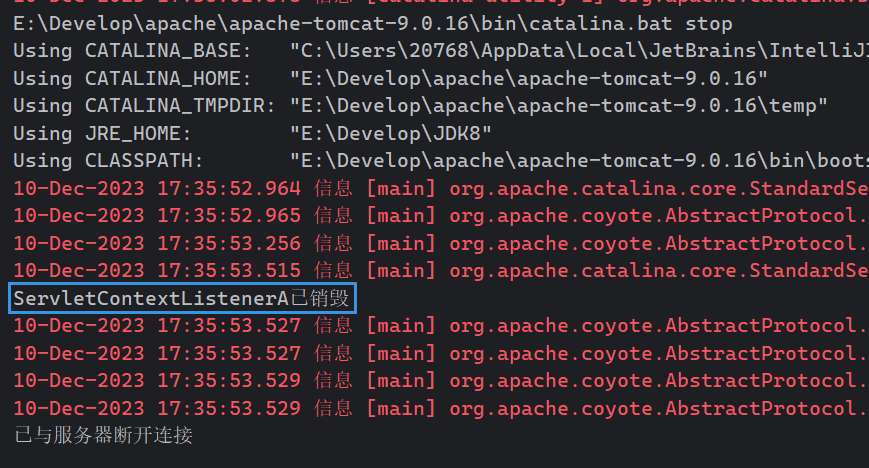
小总结:
- 当一个类实现了ServletContextListener接口,它就变成了一个监听器。ServletContextListener是Java Servlet API的一部分,它能够监听ServletContext的创建和销毁事件。
- 这个类可以监听的事件由它实现的监听接口决定。如果一个类实现了ServletContextListener,那么这个类就可以监听ServletContext的创建和销毁事件。也就是说,当web应用启动时,ServletContext对象被创建,以及当web应用关闭时,ServletContext对象被销毁,这些事件都可以被监听。
- ServletContextListenerA是一个实现了ServletContextListener接口的类,因此它也是一个监听器。当web应用启动时,会产生一个ServletContextEvent事件,这个事件会调用监听器的对应事件处理方法contextInitialized。同时,会传递一个事件对象给这个方法。
- 程序员可以通过这个事件对象,来获取需要的信息,然后再进行业务处理。例如,他们可以通过这个对象获取关于ServletContext的信息,以及关于事件类型和其他相关属性的信息。
- Tomcat知道这个监听器存在是因为我们需要在web.xml中配置它。在web.xml文件中,我们可以定义ServletContextListener,当Tomcat加载web应用时,它会读取这个文件并加载所有的ServletContextListener。这样,当web应用启动或关闭时,Tomcat就会调用这些监听器的事件处理方法。
总的来说,ServletContextListener是Java Servlet API的一部分,它允许我们监听web应用的生命周期事件。我们可以通过实现这个接口来创建自己的监听器,并在web.xml中配置它,以便Tomcat知道它的存在。
2.2.1.2. ServletContextAttributeListener监听器
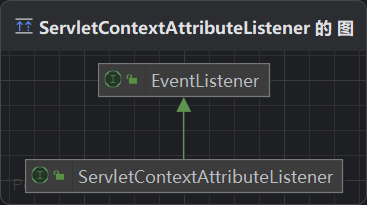
ServletContextAttributeListener监听器:监听ServletContext中属性的添加、移除和修改
ServletContextAttributeListener本身也是一个接口,继承EventListener接口
相关方法:
| 方法名 | 作用 |
| attributeAdded(ServletContextAttributeEvent scab) | 向ServletContext中添加属性时调用 |
| attributeRemoved(ServletContextAttributeEvent scab) | 从ServletContext中移除属性时调用 |
| attributeReplaced(ServletContextAttributeEvent scab) | 当ServletContext中的属性被修改时调用 |
ServletContextAttributeListener的源码:
package javax.servlet;
import java.util.EventListener;
public interface ServletContextAttributeListener extends EventListener {
/**
* Receives notification that an attribute has been added to the
* ServletContext.
*
* @param event the ServletContextAttributeEvent containing the
* ServletContext to which the attribute was added, along with the
* attribute name and value
*
* @implSpec
* The default implementation takes no action.
*/
default public void attributeAdded(ServletContextAttributeEvent event) {}
/**
* Receives notification that an attribute has been removed
* from the ServletContext.
*
* @param event the ServletContextAttributeEvent containing the
* ServletContext from which the attribute was removed, along with
* the attribute name and value
*
* @implSpec
* The default implementation takes no action.
*/
default public void attributeRemoved(ServletContextAttributeEvent event) {}
/*
* Receives notification that an attribute has been replaced
* in the ServletContext.
*
* @param event the ServletContextAttributeEvent containing the
* ServletContext in which the attribute was replaced, along with
* the attribute name and its old value
*
* @implSpec
* The default implementation takes no action.
*/
default public void attributeReplaced(ServletContextAttributeEvent event) {}
}代码举例:
ServletContextAttributeListener01.java
package listener;
import javax.servlet.ServletContextAttributeEvent;
import javax.servlet.ServletContextAttributeListener;
public class ServletContextAttributeListener01 implements ServletContextAttributeListener {
@Override // 监听ServletContext添加属性
public void attributeAdded(ServletContextAttributeEvent sce) {
System.out.println("ServletContextAttributeListener01监听到了添加属性" +
sce.getName() + "的值");
}
@Override // 监听ServletContext移除属性
public void attributeRemoved(javax.servlet.ServletContextAttributeEvent sce) {
System.out.println("ServletContextAttributeListener01监听到了移除属性" +
sce.getName() + "的值");
}
@Override // 监听ServletContext替换属性
public void attributeReplaced(javax.servlet.ServletContextAttributeEvent sce) {
System.out.println("ServletContextAttributeListener01监听到了替换属性" +
sce.getName() + "的值");
}
}ServletA.java
package servlet;
import javax.servlet.ServletContext;
import javax.servlet.annotation.WebServlet;
import javax.servlet.http.HttpServlet;
import javax.servlet.http.HttpServletRequest;
import javax.servlet.http.HttpServletResponse;
@WebServlet("/servletA") //这里servlet用的注解,不用在web.xml配置
public class ServletA extends HttpServlet {
@Override
protected void doPost(HttpServletRequest req, HttpServletResponse resp){
//给ServletContext添加属性
ServletContext servletContext = req.getServletContext();
servletContext.setAttribute("name", "Tom");
servletContext.setAttribute("name", "Jerry");
servletContext.removeAttribute("name");
System.out.println("ServletA处理完毕...");
}
@Override
protected void doGet(HttpServletRequest req, HttpServletResponse resp){
doPost(req, resp);
}
}配置web.xml

启动服务器



2.2.2. 其他监听器
除了ServletContextListener和ServletContextAttributeListener,其他的监听器用的比较少
2.2.2.1. session域监听器
2.2.2.2. HttpSessionListener 监听器
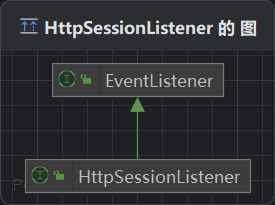
作用:HttpSessionListener 是一个监听器,用来监听 HTTP 会话的创建和销毁。
当一个 HTTP 会话被创建或销毁时,它就会触发相应的事件,我们可以编写代码来响应这些事件。
例如,在会话创建时,我们可以进行一些初始化操作;在会话销毁时,我们可以释放一些资源。这样,我们就可以在用户的状态变化时,做出相应的处理。
HttpSessionListener的源码:
package javax.servlet.http;
import java.util.EventListener;
public interface HttpSessionListener extends EventListener {
/**
* Receives notification that a session has been created.
*
* @implSpec
* The default implementation takes no action.
*
* @param se the HttpSessionEvent containing the session
*/
default public void sessionCreated(HttpSessionEvent se) {}
/**
* Receives notification that a session is about to be invalidated.
*
* @implSpec
* The default implementation takes no action.
*
* @param se the HttpSessionEvent containing the session
*/
default public void sessionDestroyed(HttpSessionEvent se) {}
}
相关方法:
| 方法名 | 作用 |
| sessionCreated(HttpSessionEvent se) | 创建session时调用 |
| sessionDestroyed(HttpSessionEvent se) | 销毁session时调用 |
2.2.2.3. HttpSessionAttributeListener 监听器

作用:HttpSessionAttributeListener 是一个用于监听 HTTP 会话属性变化的监听器。
这意味着,当会话中的属性发生添加、删除或修改时,这个监听器会接收到通知。
HttpSessionAttributeListener源码:
package javax.servlet.http;
import java.util.EventListener;
public interface HttpSessionAttributeListener extends EventListener {
/**
* Receives notification that an attribute has been added to a
* session.
*
* @param event the HttpSessionBindingEvent containing the session
* and the name and value of the attribute that was added
*/
default public void attributeAdded(HttpSessionBindingEvent event) {}
/**
* Receives notification that an attribute has been removed from a
* session.
*
* @param event the HttpSessionBindingEvent containing the session
* and the name and value of the attribute that was removed
*/
default public void attributeRemoved(HttpSessionBindingEvent event) {}
/**
* Receives notification that an attribute has been replaced in a
* session.
*
* @param event the HttpSessionBindingEvent containing the session
* and the name and (old) value of the attribute that was replaced
*/
default public void attributeReplaced(HttpSessionBindingEvent event) {}
}相关方法:
| 方法名 | 作用 |
| attributeAdded(HttpSessionBindingEvent event) | 向HttpSession添加属性时调用 |
| attributeRemoved(HttpSessionBindingEvent event) | 向HttpSession移除属性时调用 |
| attributeReplaced(HttpSessionBindingEvent event) | 向HttpSession替换属性时调用 |
2.2.2.4. request域监听器
2.2.2.5. ServletRequestListener 监听器
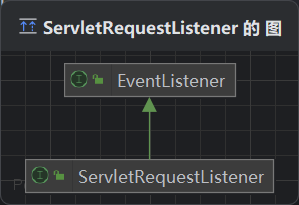
作用:监听 Request 创建或销毁,即Request生命周期监听。
ServletRequestListener的源码:
package javax.servlet;
import java.util.EventListener;
public interface ServletRequestListener extends EventListener {
/**
* Receives notification that a ServletRequest is about to go out
* of scope of the web application.
*
* @param sre the ServletRequestEvent containing the ServletRequest
* and the ServletContext representing the web application
*
* @implSpec
* The default implementation takes no action.
*/
default public void requestDestroyed(ServletRequestEvent sre) {}
/**
* Receives notification that a ServletRequest is about to come
* into scope of the web application.
*
* @param sre the ServletRequestEvent containing the ServletRequest
* and the ServletContext representing the web application
*
* @implSpec
* The default implementation takes no action.
*/
default public void requestInitialized(ServletRequestEvent sre) {}
}相关方法:
| 方法名 | 作用 |
| requestDestroyed(ServletRequestEvent sre) | 创建request时调用 |
| requestInitialized(ServletRequestEvent sre) | 销毁request时调用 |
2.2.2.6. ServletRequestAttributeListener 监听器

作用:ServletRequestAttributeListener 监听器可以监听 ServletRequest 对象中的属性变化。当属性被添加、移除或替换时,这个监听器会收到通知并执行相应的操作。
ServletRequestAttributeListener 源码:
package javax.servlet;
import java.util.EventListener;
public interface ServletRequestAttributeListener extends EventListener {
/**
* Receives notification that an attribute has been added to the
* ServletRequest.
*
* @param srae the ServletRequestAttributeEvent containing the
* ServletRequest and the name and value of the attribute that was
* added
*
* @implSpec
* The default implementation takes no action.
*/
default public void attributeAdded(ServletRequestAttributeEvent srae) {}
/**
* Receives notification that an attribute has been removed from the
* ServletRequest.
*
* @param srae the ServletRequestAttributeEvent containing the
* ServletRequest and the name and value of the attribute that was
* removed
*
* @implSpec
* The default implementation takes no action.
*/
default public void attributeRemoved(ServletRequestAttributeEvent srae) {}
/**
* Receives notification that an attribute has been replaced on the
* ServletRequest.
*
* @param srae the ServletRequestAttributeEvent containing the
* ServletRequest and the name and (old) value of the attribute
* that was replaced
*
* @implSpec
* The default implementation takes no action.
*/
default public void attributeReplaced(ServletRequestAttributeEvent srae) {}
}相关方法:
| 方法名 | 作用 |
| attributeAdded(ServletRequestAttributeEvent srae) | 向Request添加属性时调用 |
| attributeRemoved(ServletRequestAttributeEvent srae) | 向Request移除属性时调用 |
| attributeReplaced(ServletRequestAttributeEvent srae) | 向Request替换属性时调用 |
2.2.3. session域的两个特殊监听器
2.2.3.1. HttpSessionBindingListener 监听器
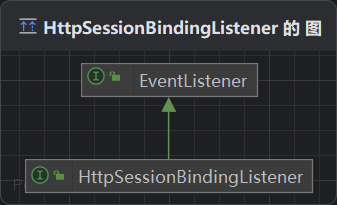
HttpSessionBindingListener 监听器也叫session绑定监听器
作用:HttpSessionBindingListener 监听 HttpSession 中对象的添加和移除,以确保数据的准确性和一致性。它可以帮助我们跟踪数据变化并触发相应操作。
HttpSessionBindingListener 监听器用于监听某个对象在 HttpSession 中的添加和移除操作。当该对象被添加到 HttpSession 中或从 HttpSession 中移除时,监听器会自动执行相应的操作。这个监听器通常用于管理在 HttpSession 中存储的数据,确保数据的一致性和准确性。
简单来说,它可以帮助我们跟踪 HttpSession 中数据的变化,并触发相应的操作。
HttpSessionBindingListener源码:
package javax.servlet.http;
import java.util.EventListener;
public interface HttpSessionBindingListener extends EventListener {
/**
*
* Notifies the object that it is being bound to
* a session and identifies the session.
*
* @implSpec
* The default implementation takes no action.
*
* @param event the event that identifies the
* session
*
* @see #valueUnbound
*
*/
default public void valueBound(HttpSessionBindingEvent event) {}
/**
*
* Notifies the object that it is being unbound
* from a session and identifies the session.
*
* @implSpec
* The default implementation takes no action.
*
* @param event the event that identifies
* the session
*
* @see #valueBound
*
*/
default public void valueUnbound(HttpSessionBindingEvent event) {}
}
相关方法:
| 方法名 | 作用 |
| valueBound(HttpSessionBindingEvent event) | 该类的实例被放到Session域中时调用 |
| void valueUnbound(HttpSessionBindingEvent event) | 该类的实例从Session中移除时调用 |
2.2.3.2. HttpSessionActivationListener 监听器
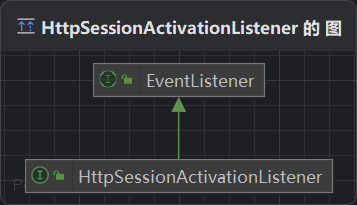
HttpSessionActivationListener 监听器也叫钝化活化监听器
作用:HttpSessionActivationListener 监听 HttpSession 中对象的序列化和反序列化。在分布式系统中,它帮助处理对象的存储和恢复,允许在序列化和反序列化时执行特定操作。
HttpSessionActivationListener 的源码:
package javax.servlet.http;
import java.util.EventListener;
public interface HttpSessionActivationListener extends EventListener {
/**
* Notification that the session is about to be passivated.
*
* @implSpec
* The default implementation takes no action.
*
* @param se the {@link HttpSessionEvent} indicating the passivation
* of the session
*/
default public void sessionWillPassivate(HttpSessionEvent se) {}
/**
* Notification that the session has just been activated.
*
* @implSpec
* The default implementation takes no action.
*
* @param se the {@link HttpSessionEvent} indicating the activation
* of the session
*/
default public void sessionDidActivate(HttpSessionEvent se) {}
} 相关方法:
| 方法名 | 作用 |
| sessionWillPassivate(HttpSessionEvent se) | 该类实例和Session一起钝化到硬盘时调用 |
| sessionDidActivate(HttpSessionEvent se) | 该类实例和Session一起活化到内存时调用 |
本文来自互联网用户投稿,该文观点仅代表作者本人,不代表本站立场。本站仅提供信息存储空间服务,不拥有所有权,不承担相关法律责任。 如若内容造成侵权/违法违规/事实不符,请联系我的编程经验分享网邮箱:veading@qq.com进行投诉反馈,一经查实,立即删除!